1993 CHEVROLET ASTRO PASSENGER overheating
[x] Cancel search: overheatingPage 116 of 345
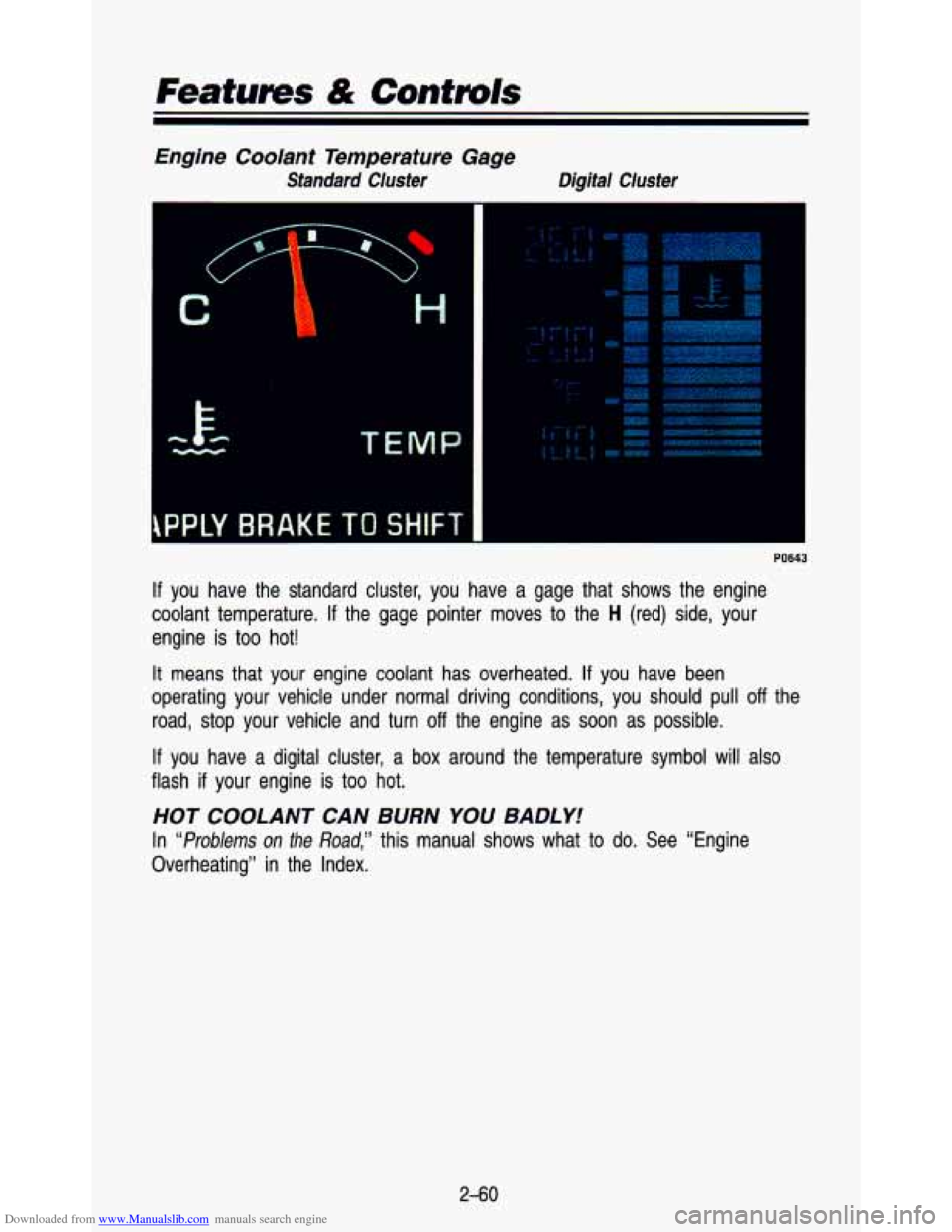
Downloaded from www.Manualslib.com manuals search engine Features & Controls
Engine Coolant Temperature Gage
Standard CIuster Digital Cluster
TEMP
PPLY BRAKE TO SHIFT
PO643
If you have the standard cluster, you have a gage that shows the\
engine
coolant temperature.
If the gage pointer moves to the H (red) side, your
engine is too hot!
It means that your engine coolant has overheated.
If you have been
operating your vehicle under normal driving conditions, you shou\
ld pull
off the
road, stop your vehicle and turn
off the engine as soon as possible.
If you have a digital cluster, a
box around the temperature symbol will also
flash
if your engine is too hot.
HOT COOLANT CAN BURN YOU BADLY!
In “Problems on the Road,” this manual shows what to do. See “Engine
Overheating” in the Index.
2-60
Page 202 of 345
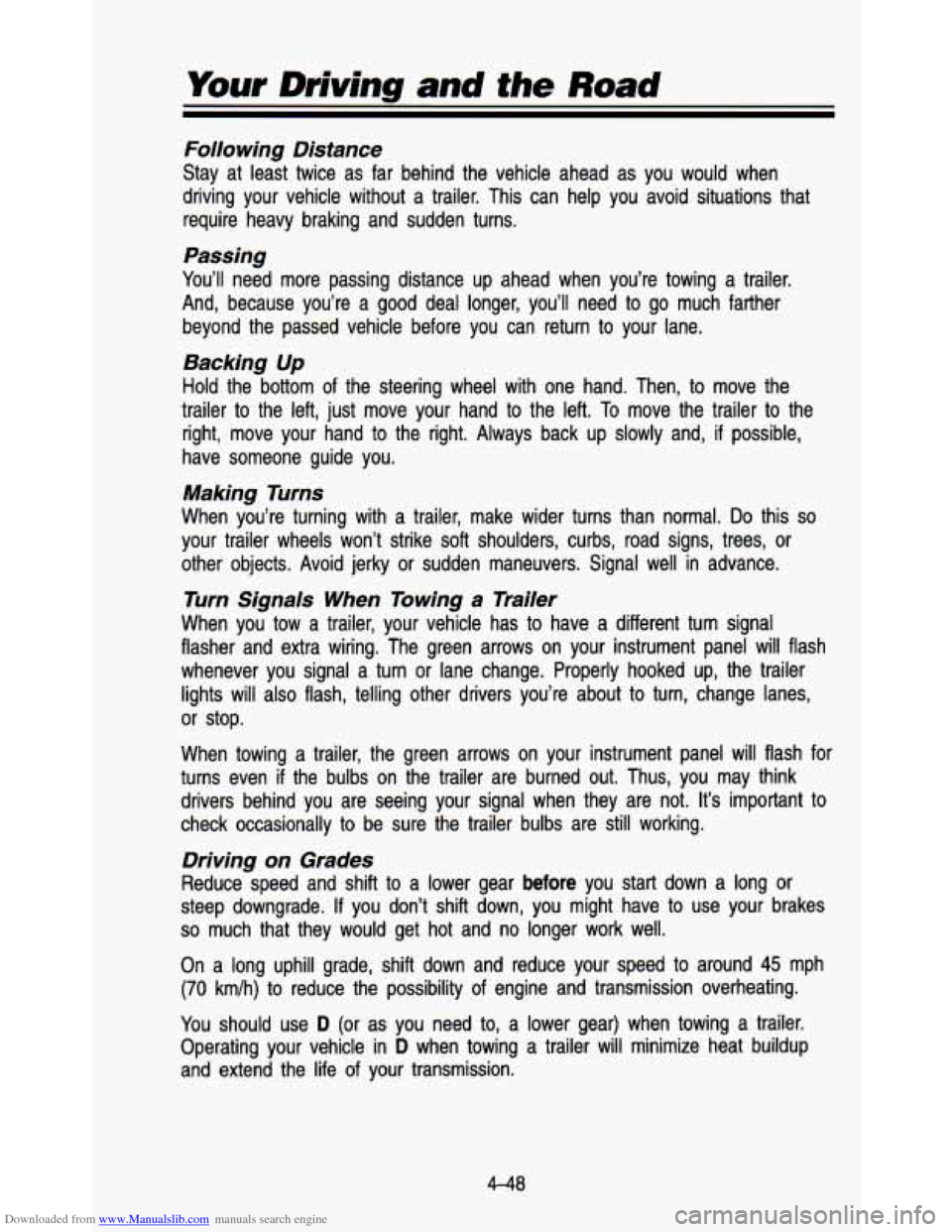
Downloaded from www.Manualslib.com manuals search engine Your Driving and the Road
Following Distance
Stay at least twice as far behind the vehicle ahead as you w\
ould when
driving your vehicle without a trailer. This can help you avoi\
d situations that require heavy braking and sudden turns.
Passing
You’ll need more passing distance up ahead when you’re to\
wing a trailer.
And, because you’re a good deal longer, you’ll need
to go much farther
beyond the passed vehicle before you can return
to your lane.
Backing Up
Hold the bottom of the steering wheel with one hand. Then, to move the
trailer to the left, just move your hand to the left.
To move the trailer to the
right, move your hand to the right. Always back up slowly and\
, if possible,
have someone guide you.
Making Turns
When you’re turning with a trailer, make wider turns than n\
ormal. Do this so
your trailer wheels won’t strike soft shoulders, curbs, road \
signs, trees, or
other objects. Avoid jerky or sudden maneuvers. Signal well in advance.
Turn Signals When Towing a Trailer
When you tow a trailer, your vehicle has to have a different turn signal
flasher and extra wiring. The green arrows on your instrument \
panel will flash
whenever you signal a turn or lane change. Properly hooked up,\
the trailer lights will also flash, telling other drivers you’re about to turn, change lanes,
or stop.
When towing a trailer, the green arrows on your instrument pan\
el will flash for
turns even
if the bulbs on the trailer are burned out. Thus, you may think \
drivers behind you are seeing your signal when they are not. \
It’s important to
check occasionally
to be sure the trailer bulbs are still working.
Driving on Grades
Reduce speed and shift to a lower gear before you start down a long or
steep downgrade. If you don’t shift down, you might have to use your brakes
so much that they would get hot and no longer work well.
On a long uphill grade, shift down and reduce your speed to \
around
45 mph
(70 km/h) to reduce the possibility of engine and transmission overheating.
You should use
D (or as you need to, a lower gear) when towing a trailer.
Operating your vehicle in
D when towing a trailer will minimize heat buildup
and extend the life
of your transmission.
4-48
Page 205 of 345
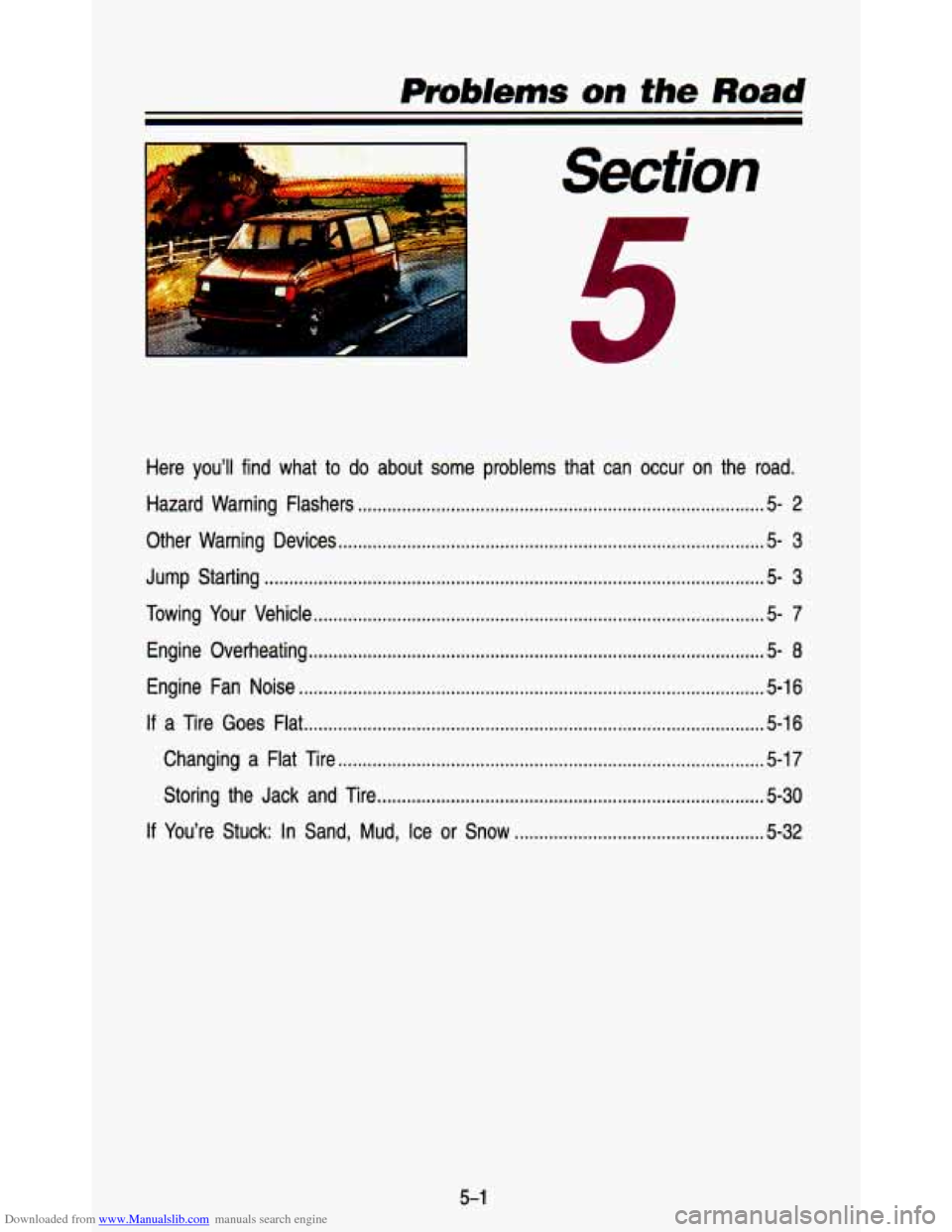
Downloaded from www.Manualslib.com manuals search engine I m Section
Here you’ll find what to do about some problems that can occur on the road .
Hazard Warning Flashers ........................................................................\
........... 5-2
Other Warning Devices ........................................................................\
............... 5-3
Jump Starting ........................................................................\
.............................. 5-3
Towing Your Vehicle ........................................................................\
.................... 5-7
Engine Overheating ........................................................................\
..................... 5-8
Engine Fan Noise ........................................................................\
....................... 5.16
a Tire Goes Flat ........................................................................\
...................... 5-16
Changing a Flat Tire ........................................................................\
............... 5-17
Storing the Jack and Tire ........................................................................\
....... 5-30
You’re Stuck: In Sand, Mud, Ice or Snow ................................................... 5-32
5-1
Page 212 of 345
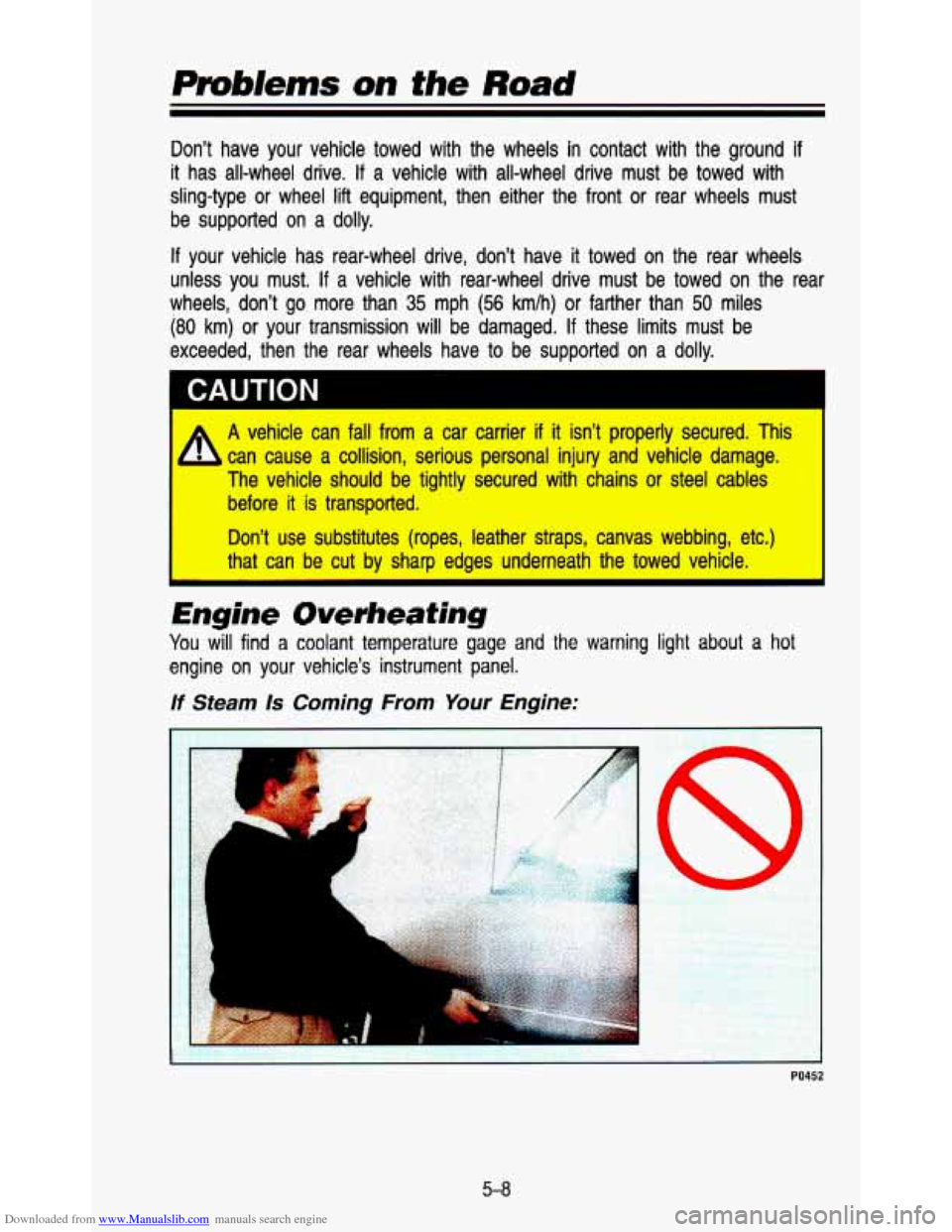
Downloaded from www.Manualslib.com manuals search engine Don’t have your vehicle towed with the wheels in contact with the ground if
it has all-wheel drive. If a vehicle with all-wheel drive must be towed with
sling-type
or wheel lift equipment, then either the front or rear wheels must
be supported on a dolly.
If your vehicle has rear-wheel drive, don’t have it towed on t\
he rear wheels
unless you must.
If a vehicle with rear-wheel drive must be towed on the rear
wheels, don’t go more than
35 mph (56 kmlh) or farther than 50 miles
(80 km) or your transmission will be damaged. If these limits must be
exceeded, then the rear wheels have to be supported on a doll\
y.
1 CAUTION
L A vehicle can fall from a car carrier if it isn’t properly secured. This
b can cause a collision, serious personal injury and vehicle dama\
ge.
The vehicle should be tightly secured with chains or steel cab\
les
before it is transported.
Don’t use substitutes (ropes, leather straps, canvas webbing,\
etc.)
that can be
cut by sharp edges underneath the towed vehicle.
Engine Overheating
You will find a coolant temperature gage and the warning light about a hot
engine on your vehicle’s instrument panel.
If Steam Is Coming From Your Engine:
PO452
5-8
Page 262 of 345
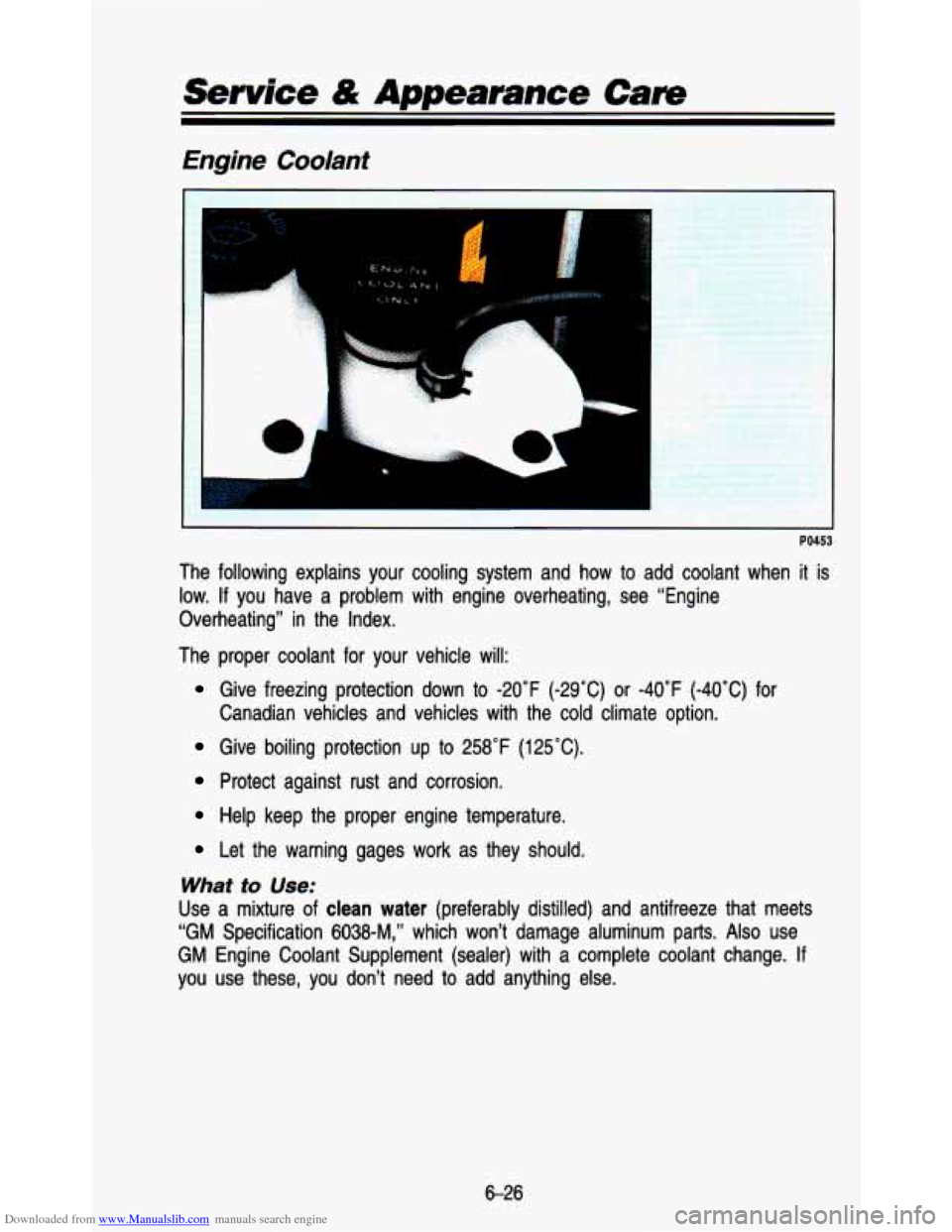
Downloaded from www.Manualslib.com manuals search engine Engine Coolant
~
L
A
1
PO453
The following explains your cooling system and how to add cool\
ant when it is low.
If you have a problem with engine overheating, see "Engine
Overheating" in the Index.
The proper coolant for your vehicle will:
Give freezing protection down to -20°F (-29°C) or -40°F (-40°C) for
Canadian vehicles and vehicles with the cold climate option.
Give boiling protection up to 258°F (125°C).
Protect' against rust and corrosion.
Help keep the proper engine temperature.
Let the warning gages work as they should,
What to Use:
Use a mixture of clean water (preferably distilled) and antifreeze that meets
"GM Specification 6038-M," which won't damage aluminum parts.
Also use
GM Engine Coolant Supplement (sealer) with a complete coolant \
change.
If
you use these, you don't need to add anything else.
6-26
Page 265 of 345
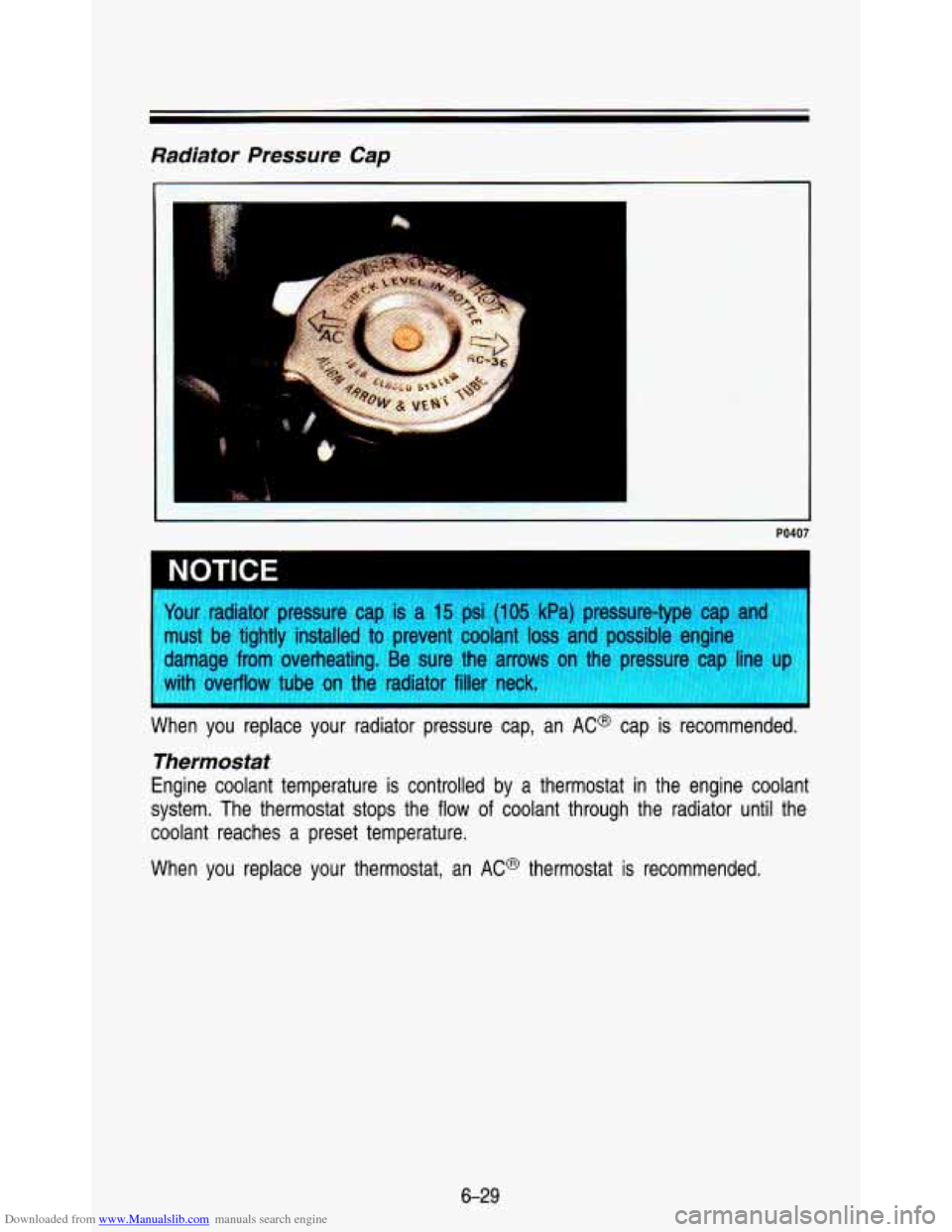
Downloaded from www.Manualslib.com manuals search engine Radiator Pressure Cap
PO407
"wr radiator pressure cap is a 15 psi (1 05 kPa) pressure-type cap and
wst be tightly installed to prevent coolant
loss and possible engine
damage from overheating. Be sure the arrows on the pressure cap
lir
with overflow tube on the radiator filler neck.
I
I
When you replace your radiator pressure cap, ul~ AC@ cap is IGdommendGu.
Thermostat
Engine coolant temperature is controlled by a thermostat in the\
engine coolant
system. The thermostat stops the flow
of coolant through the radiator until the
coolant reaches a preset temperature.
When you replace your thermostat, an AC@ thermostat is recommended.
6-29
Page 281 of 345
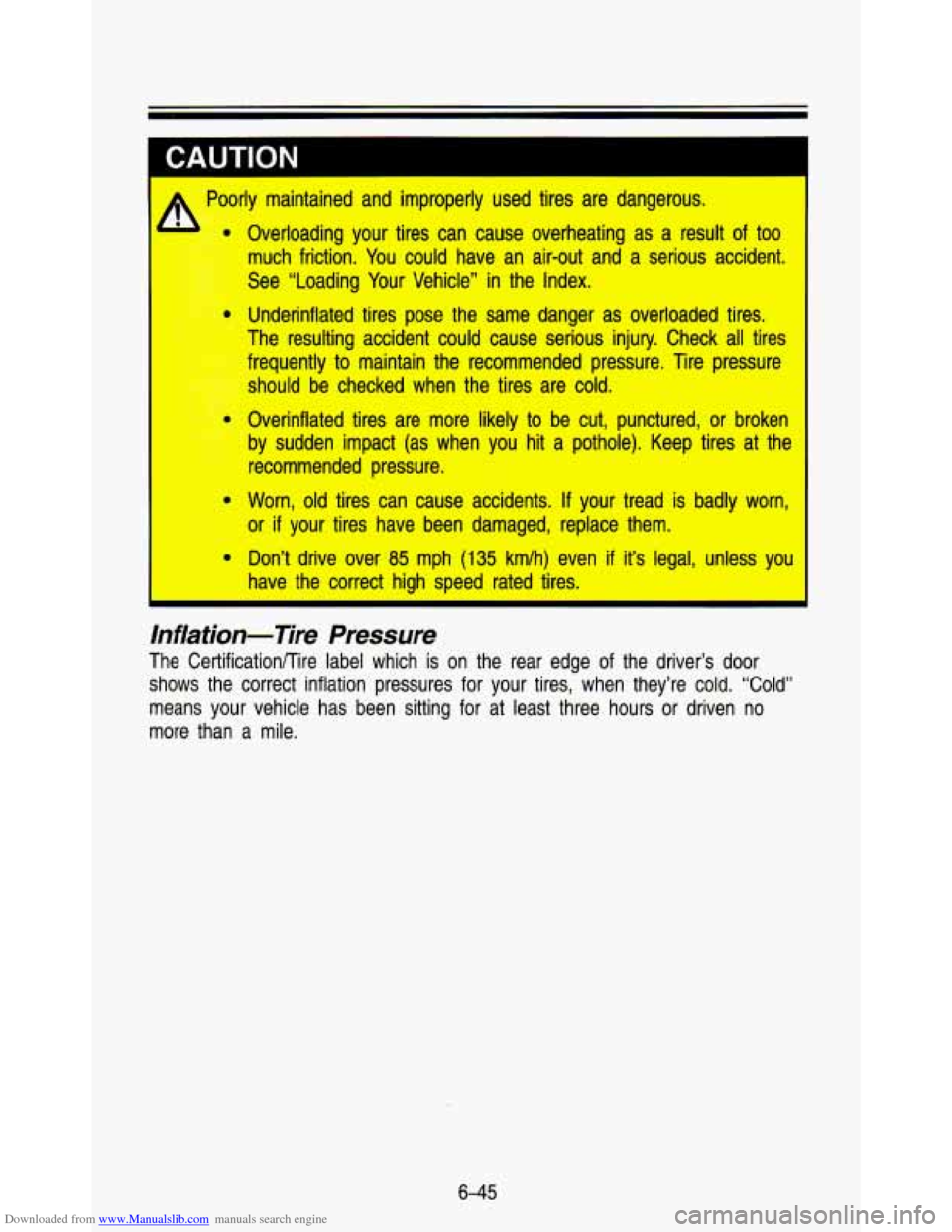
Downloaded from www.Manualslib.com manuals search engine A Poorly maintained and improperly used tires are dangerous. Overloading your tires can cause overheating as a result of too
much friction.
You could have an air-out and a serious accident.
See “Loading Your Vehicle” in the Index.
Underinflated tires pose the same danger as overloaded tires.
The resulting accident could cause serious injury. Check all ti\
res
frequently to maintain the recommended pressure. Tire pressure
should be checked when the tires are cold.
Overinflated tires are more likely to be cut, punctured, or broken
by sudden impact (as when you hit a pothole). Keep tires at\
the recommended pressure.
Worn, old tires can cause accidents.
If your tread is badly worn,
or
if your tires have been damaged, replace them.
Don’t drive over
85 mph (1 35 km/h) even if it’s legal, unless you
have the correct high speed rated tires.
Inflation-Tire Pressure
The Certification/Tire label which is on the rear edge of the driver’s door
shows the correct inflation pressures for your tires, when they’re cold\
. “Cold”
means your vehicle has been sitting for at least three hours \
or driven no
more than a mile.
6-45
Page 339 of 345

Downloaded from www.Manualslib.com manuals search engine ..
.
E
Engine Block Heater
..................... 2.16. 3-9
Coolant
............................ 5.11. 6-26
Coolant Temperature Gage
...... 2-60
Cover
......................................... 6-1 5
Exhaust ............................ 2.24. 6-41
Fan Noise
.................................. 5-1 6
Identification
..................... 6.60. 6-64
Oil (See “Oil”) Overheating
................................. 5-8
Running While Parked
... 2.22. 2-25
Equipment. Add-on
...................... 6-44
Exhaust System
............................ 6-41
F
Finish Care
........................................... 6-56
Damage
..................................... 6-57
Automatic Transmission
............ 6-20
Brake
......................................... 6-32
Capacities
.................................. 6-64
Coolant
............................ 5.11. 6-26
Leak Check
............................... 6-34
Power Steering
......................... 6-30
Transfer Case
........................... 6-23
Windshield Washer
................... 6-31
Fog Lamps
.................................... 2-42
Four-wheel Antilock
..................... 4-1 5
Front Seats ..................................... 1-2
Fuel
................................................. 6-4
Gage
.......................................... 2-63
In Foreign Countries
................... 6-6
Regulator
................................... 2-1 5
Tank Capacity ........................... 6-65
Fuse Block
.................................... 6-63
Fuses and Circuit Breakers
......... 6-68
Fluid
Filling Your Tank
......................... 6-6
G
Gages
Fuel ............................................ 2-63 ....
Voltmeter .................................... 2-64
Gasolines for Cleaner Air
.............. 6-5
H
Hatch Release Switch .................. 2-27
Hazard Warning Flashers
.............. 5-2
Head Restraints
............................ 1-11
Headlights
...................................... 6-35
High Beams
..................... 2.66. 4-24
High-Low Beam
......................... 2-31
Reminder Light
.......................... 2-44
Heating System
.............................. 3-5
Fan Lever
.................................... 3-5
Rear
............................................. 3-7
Temperature Lever
...................... 3-5
Highway Hypnosis
........................ 4-34
Hitches Hood Block Heater.,
............................ 2-16
Function Lever
............................ 3-5
4-46
...........................................
Latches and Hinge ................... 6-40
Release
........................................ 6-8
Horn
............................................... 2-28
Hydroplaning
................................. 4-27
I
If You’re Stuck in Sand. Mud.
Ice or Snow
.............................. 5-32
Ignition Switch
............................... 2-13
Inflation-Tire Pressure
................... 6-45
Instrument Cluster
........................ 2-52
Standard
.................................... 2-55
Digital
......................................... 2-52
J
Jack Storage ................................. 5-18
Jump Starting
.................................. 5-3
9-3